Themed collection Editors’ collection: Supramolecular Chemistry

Bioinspired temporal supramolecular polymerization
Nature's fuel-driven approach as a generic concept for structural and temporal regulation over biomimetic synthetic supramolecular polymerization.

RSC Adv., 2018,8, 18913-18925
https://doi.org/10.1039/C8RA03225D
Promising advances of thiacalix[4]arene in crystal structures
Thiacalix[4]arenes are one kind of robust scaffolds and extensively applied in supramolecular chemistry and materials science owing to their novel features.
![Graphical abstract: Promising advances of thiacalix[4]arene in crystal structures](/en/Image/Get?imageInfo.ImageType=GA&imageInfo.ImageIdentifier.ManuscriptID=C6RA25616C&imageInfo.ImageIdentifier.Year=2017)
RSC Adv., 2017,7, 10021-10050
https://doi.org/10.1039/C6RA25616C
Hyperporphyrin effects extended into a J-aggregate supramolecular structure in water
5-(4-Aminophenyl)-10,15,20-tris(4-sulfonatophenyl)porphyrin in acidic water self-assembles into a J-aggregate exhibiting a prominently red-shifted hyperporphyrin-type Q-absorption band at 742 nm.
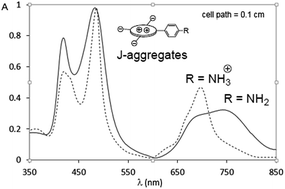
RSC Adv., 2017,7, 3353-3357
https://doi.org/10.1039/C6RA27441B
Self-assembled pH-responsive supramolecular hydrogel for hydrophobic drug delivery
Supramolecular hydrogel, AGC16/NTS, was used to encapsulate hydrophobic drug curcumin (Cur), constructing a pH-responsive drug delivery system; the uptake of released Cur by cancer cells also occurred.

RSC Adv., 2018,8, 31581-31587
https://doi.org/10.1039/C8RA06064A
Preparation of prolinamide with adamantane for aldol reaction catalysis in brine and separation using a poly(AN-MA-β-CD) nanofibrous film via host–guest interaction
Prolinamide with adamantane catalyzed the aldol reaction. The reaction of cyclohexanone with m-nitrobenzaldehyde assessed recyclability of catalyst. After run, the catalyst was adsorbed with nanofibrous of polymer via host–guest interaction.
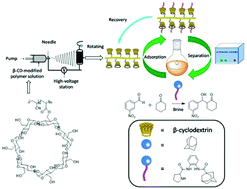
RSC Adv., 2018,8, 28376-28385
https://doi.org/10.1039/C8RA04802A
Design of melt-recyclable poly(ε-caprolactone)-based supramolecular shape-memory nanocomposites
Novel melt-recyclable poly(ε-caprolactone)/cellulose nanocrystals supramolecular nanocomposite networks with shape-memory behavior have been successfully constructed by playing with UPy chemistry.
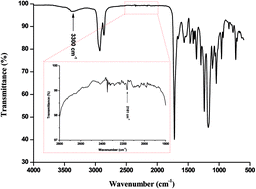
RSC Adv., 2018,8, 27119-27130
https://doi.org/10.1039/C8RA03832E
A novel self-healing power cable insulating material based on host–guest interactions
The insulating materials used in power cables are susceptible to damage and cracks during installation and operation.
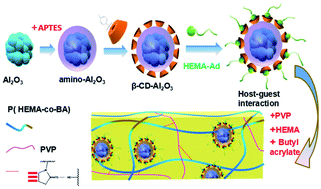
RSC Adv., 2018,8, 25313-25318
https://doi.org/10.1039/C8RA04882G
A fluorescent calixarene-based dimeric capsule constructed via a MII–terpyridine interaction: cage structure, inclusion properties and drug release
A fluorescent calixarene-based dimeric capsule has been constructed via a MII–terpyridine interaction, and can capture mercaptopurine in solution and crystalline state and control drug release in PBS accompanied with fluorescence recovery.

RSC Adv., 2018,8, 22530-22535
https://doi.org/10.1039/C8RA02146E
Fluorescent supramolecular hydrogels self-assembled from tetraphenylethene (TPE)/single amino acid conjugates
TPE-Ser molecules exhibit non-covalent interactions necessary for hydrogelation under physiological pH conditions.

RSC Adv., 2018,8, 20922-20927
https://doi.org/10.1039/C8RA02296H
Supramolecular hydrogels encapsulating bioengineered mesenchymal stem cells for ischemic therapy
We developed supramolecular hydrogels encapsulating bioengineered mesenchymal stem cells for ischemia therapy.

RSC Adv., 2018,8, 18771-18775
https://doi.org/10.1039/C8RA00464A
pH-responsive molecular assemblies of pyridylbutadiene derivative with cucurbit[7]uril
pH-responsive emission behavior of supramolecular complexes between pyridylbutadiene with CB7 and formation of molecular assemblies is described.
![Graphical abstract: pH-responsive molecular assemblies of pyridylbutadiene derivative with cucurbit[7]uril](/en/Image/Get?imageInfo.ImageType=GA&imageInfo.ImageIdentifier.ManuscriptID=C8RA03355B&imageInfo.ImageIdentifier.Year=2018)
RSC Adv., 2018,8, 16738-16745
https://doi.org/10.1039/C8RA03355B
The role of amino acids on supramolecular co-assembly of naphthalenediimide–pyrene based hydrogelators
The importance of side chains of amino acids for NDI–Py co-assembled hydrogelation is described.
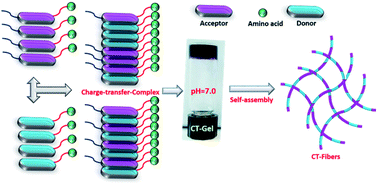
RSC Adv., 2018,8, 14753-14759
https://doi.org/10.1039/C8RA00929E
Multi-mode supermolecular polymerization driven by host–guest interactions
Multi-morphology supramolecular polymers from linear to dendritic polymerization by the introduction of azobenzene were obtained based on host–guest interaction.
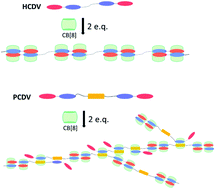
RSC Adv., 2018,8, 13722-13727
https://doi.org/10.1039/C8RA01892H
A ratiometric fluorescence assay for acetylcholinesterase activity and inhibitor screening based on supramolecular assembly induced monomer–excimer emission transition of a perylene probe
The PDI-DHA can aggregate to form supramolecular assemblies when mixed with lauroylcholine and lauric acid, and is employed as a ratiometric fluorescence probe for the detection of AChE activity.
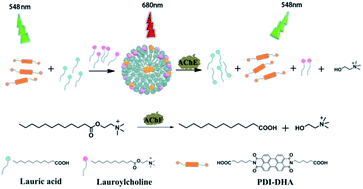
RSC Adv., 2018,8, 12785-12790
https://doi.org/10.1039/C8RA01274A
Targeting protein-loaded CB[8]-mediated supramolecular nanocarriers to cells
Supramolecular amphiphilic complexes of cucurbit[8]uril (CB[8]), alkylated paraquat and RGD-modified azobenzene self-assemble into vesicles of 200 nm in diameter that, after loading with proteins, were used for cell targeting.
![Graphical abstract: Targeting protein-loaded CB[8]-mediated supramolecular nanocarriers to cells](/en/Image/Get?imageInfo.ImageType=GA&imageInfo.ImageIdentifier.ManuscriptID=C7RA10980F&imageInfo.ImageIdentifier.Year=2017)
RSC Adv., 2017,7, 54341-54346
https://doi.org/10.1039/C7RA10980F
A novel self-assembled supramolecular sensor based on thiophene-functionalized imidazophenazine for dual-channel detection of Ag+ in an aqueous solution
A novel dual-channel chemosensor S1 is designed and synthesized, which recognizes Ag+ over other metal ions with high selectivity and sensitivity.

RSC Adv., 2017,7, 53439-53444
https://doi.org/10.1039/C7RA09597J
Supramolecular self-assembly of a polyelectrolyte chain based on step-growth polymerization of hydrophobic and hydrophilic monomers
Polymerization of citric acid and hexamethylene diisocyanate and hydrolysis results in a polyelectrolyte PHMC. Noncovalent cross-linking of cooperative H-bonding units stabilizes the self-assembly of the PHMC chains into nanoparticles in water.

RSC Adv., 2017,7, 52832-52840
https://doi.org/10.1039/C7RA09205A
Transformable protein–gold hybrid materials serve as supramolecular vehicles for gene delivery
PGHN–DNA can be a good model to study DNA–carrier interaction as well as a new carrier for gene delivery research.

RSC Adv., 2017,7, 51252-51256
https://doi.org/10.1039/C7RA10141D
Viscoelastic properties of supramolecular gemini-like surfactant solutions in the absence of inorganic salts
A bola-type cation and a newly synthesized anionic surfactant together generate a supramolecular gemini-like structure via electrostatic interactions, which facilitates the formation of wormlike micelles.

RSC Adv., 2017,7, 48120-48126
https://doi.org/10.1039/C7RA08435H
pH-Responsive nanofiltration membranes based on porphyrin supramolecular self-assembly by layer-by-layer technique
A novel pH-responsive nanofiltration membrane was fabricated by means of layer-by-layer technique based on porphyrin supramolecular self-assembly.
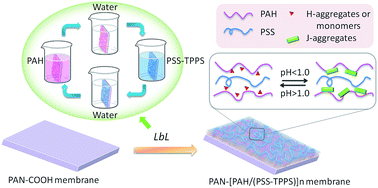
RSC Adv., 2017,7, 47397-47406
https://doi.org/10.1039/C7RA08568K
Dynamic self-assembled polymer: HCl responsive inversion of supramolecular polymer handedness
Discotic trisamide formed a self-assembled polymer and exhibits inversion of supramolecular polymer handedness in the presence of HCl.

RSC Adv., 2017,7, 47170-47176
https://doi.org/10.1039/C7RA08035B
Cage to cage study of ionic liquid and cyclic oligosaccharides to form inclusion complexes
Encapsulation of trihexyltetradecylphosphonium chloride inside α and β-cyclodextrins in both aqueous solution and solid state with 1 : 1 stoichiometry.

RSC Adv., 2017,7, 40803-40812
https://doi.org/10.1039/C7RA08397A
Supramolecular control of liquid crystals by doping with halogen-bonding dyes
Halogen bonding between photoactive guest dopants and liquid-crystal host enhances the optical performance of doped liquid crystals.

RSC Adv., 2017,7, 40237-40242
https://doi.org/10.1039/C7RA06397K
E/Z isomerization effects on aggregation-enhanced emission of tetraphenylethene derivatives assisted by host–guest recognition
Pure E and Z stereoisomers of tetraphenylethene derivatives functionalized with dibenzylamine groups were isolated. Both supramolecular polymerization and photophysical changes were more significant in the case of the former than in the latter.
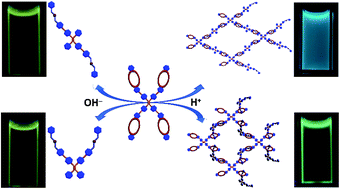
RSC Adv., 2017,7, 38581-38585
https://doi.org/10.1039/C7RA06475F
An efficient iodide ion chemosensor and a rewritable dual-channel security display material based on an ion responsive supramolecular gel
The ion stimuli-responsive metallogel PbG could act as a highly selective and sensitive I− sensor and a rewritable dual-channel security display material.
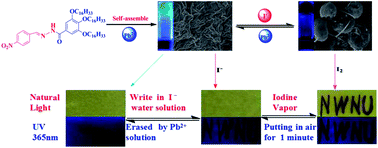
RSC Adv., 2017,7, 38210-38215
https://doi.org/10.1039/C7RA06238A
A supramolecular self-assembly host–guest system from cyclodextrin as an absolute water-soluble fluorescence sensor for aluminium ions: synthesis, characterization and sensing activity
In the study, an organic molecule derived from paeonol and anthraniloyl hydrazine (L) was synthesized via a Schiff-base reaction.

RSC Adv., 2017,7, 38160-38165
https://doi.org/10.1039/C7RA06915D
Effect of metal–metal distance in Ni(II)-based metallo-supramolecular polymers: DNA binding and cytotoxicity
Two metallo-supramolecular polymers (polyNiL1 and polyNiL2) with different metal–metal distances were synthesized via (1 : 1) complexation of the Ni salts with bis(1,10-phenanthroline)s and their DNA binding properties and cytotoxicity were revealed.
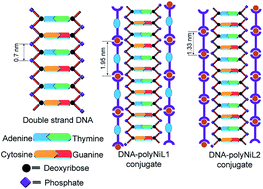
RSC Adv., 2017,7, 38008-38013
https://doi.org/10.1039/C7RA05644C
Solvent-induced construction of two zinc supramolecular isomers: synthesis, framework flexibility, sensing properties, and adsorption of dye molecules
Solvent-induced construction of two zinc supramolecular isomerism, sensing properties and adsorption of dye molecules.
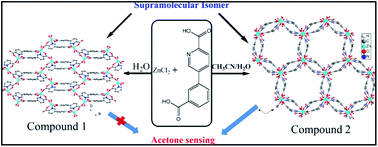
RSC Adv., 2017,7, 36575-36584
https://doi.org/10.1039/C7RA05049F
Highly efficient FRET from aggregation-induced emission to BODIPY emission based on host–guest interaction for mimicking the light-harvesting system
A novel highly efficient FRET system from aggregation-induced emission to BODIPY emission based on the host–guest interaction for mimicking a light harvesting system was disclosed with a FRET efficiency up to 93%

RSC Adv., 2017,7, 36021-36025
https://doi.org/10.1039/C7RA05925F
Neutral linear supramolecular polymers constructed by three different interactions
Neutral linear supramolecular polymers were constructed by the combination of quadruple hydrogen bonding, pillar[5]arene-based molecular recognition and π–π donor–acceptor interactions.
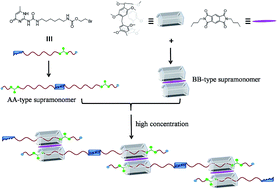
RSC Adv., 2017,7, 29364-29367
https://doi.org/10.1039/C7RA05351G
Supramolecular interactions via hydrogen bonding contributing to citric-acid derived carbon dots with high quantum yield and sensitive photoluminescence
Fluorophores coupled with supramolecules lead to “dot” topologies in citric-acid derived carbon dots under the effect of hydrogen bonding.
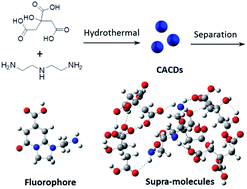
RSC Adv., 2017,7, 20345-20353
https://doi.org/10.1039/C7RA02160G
Emission enhancement of GFP chromophore in aggregated state via combination of self-restricted effect and supramolecular host–guest complexation
The emission response of GFP chromophore in aggregated state is greatly enhanced more than 100-fold due to the inhibition of conformational motion and the reduction of strong π–π interaction.

RSC Adv., 2017,7, 17980-17987
https://doi.org/10.1039/C7RA00974G
pH-Controlled recognition of amino acids by urea derivatives of β-cyclodextrin
Water soluble amphiphilic urea-substituted β-cyclodextrins were synthesized and applied as amino acid receptors.

RSC Adv., 2017,7, 15742-15746
https://doi.org/10.1039/C7RA02127E
One-step preparation of conjugated homopolymer sub-microspheres via a controllable supramolecular approach toward optoelectronic applications
Supramolecular PPFOH-based conjugated polymer sub-microspheres (CPSMs) are constructed via “one step” solvent evaporation induced interface self-assembly (SEIS), which pave a way to construct colloidal crystal and light-emitting diodes.

RSC Adv., 2017,7, 14688-14693
https://doi.org/10.1039/C6RA28859F
Synthesis and characterization of metallo-supramolecular polymers from thiophene-based unimers bearing pybox ligands
A series of novel metallo-supramolecular polymers was prepared, based on 2,6-bis(2-oxazolinyl)pyridine chelating groups bridged with thiophene, bithiophene and thienothiophene as a linker, beginning from commercially available (chelidamic) acid.
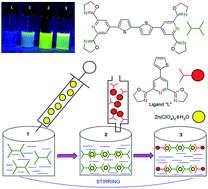
RSC Adv., 2017,7, 10718-10728
https://doi.org/10.1039/C6RA26665G
Inclusion complexes of norepinephrine with β-cyclodextrin, 18-crown-6 and cucurbit[7]uril: experimental and molecular dynamics study
Binary and ternary complexes of norepinephrine with 18C6, βCD and CB7 have been characterized using various experimental and theoretical techniques.
![Graphical abstract: Inclusion complexes of norepinephrine with β-cyclodextrin, 18-crown-6 and cucurbit[7]uril: experimental and molecular dynamics study](/en/Image/Get?imageInfo.ImageType=GA&imageInfo.ImageIdentifier.ManuscriptID=C6RA28638K&imageInfo.ImageIdentifier.Year=2017)
RSC Adv., 2017,7, 9888-9901
https://doi.org/10.1039/C6RA28638K
Synthesis and investigation of a self-assembled hydrogel based on hydroxyethyl cellulose and its in vitro ibuprofen drug release characteristics
IBU is solubilized and encapsulated by β-CDP. Then C12 side-chain grafting onto HEC forms inclusion complexes with the cavities of β-CDP in β-CDP/IBU through host–guest interactions to form a new self-assembled hydrogel gel-(β)CDP-HEC/IBU.
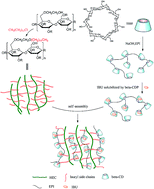
RSC Adv., 2017,7, 9500-9511
https://doi.org/10.1039/C6RA25355E
Conversion of supramolecular organic framework to uranyl-organic coordination complex: a new “matrix-free” strategy for highly efficient capture of uranium
Conversion of hydrogen-bonded supramolecular organic frameworks (HSOF) to a uranyl-organic coordination complex (UOCC) by uranyl-induced disassembly and reassembly: innovative “matrix-free” strategy for highly efficient uranium capture.
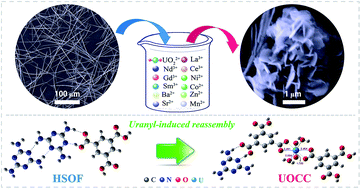
RSC Adv., 2017,7, 8985-8993
https://doi.org/10.1039/C6RA28356J
Fluorescein hydrazone-based supramolecular architectures, molecular recognition, sequential logic operation and cell imaging
A fluorescein hydrazone (FDNS) displays molecular recognition of multiple ions with its supramolecular architectures. Real sample analysis, cell imaging, paper strip detection and sequential logic operation endows FDNS of great economic significance.
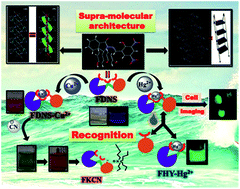
RSC Adv., 2017,7, 2264-2272
https://doi.org/10.1039/C6RA26255D
Hindrance of photodimerization of coumarin derivative induced by pillar[5]arene-based molecular recognition in water
An easy and simple method for the impediment of the photodimerization of coumarin derivative induced by pillar[5]arene-based molecular recognition was provided. Moreover, we successfully use this system in supra-amphiphile self-assembly in water.
![Graphical abstract: Hindrance of photodimerization of coumarin derivative induced by pillar[5]arene-based molecular recognition in water](/en/Image/Get?imageInfo.ImageType=GA&imageInfo.ImageIdentifier.ManuscriptID=C6RA26741F&imageInfo.ImageIdentifier.Year=2017)
RSC Adv., 2017,7, 1593-1596
https://doi.org/10.1039/C6RA26741F
A novel H2O2 responsive supramolecular hydrogel for controllable drug release
We reported a peptide-based supramolecular hydrogel possessing a gel–sol phase transition triggered by H2O2.
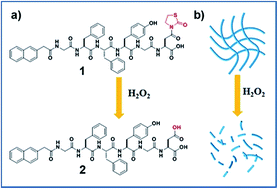
RSC Adv., 2017,7, 1313-1317
https://doi.org/10.1039/C6RA26536G
On the stability of lithocholate derivative supramolecular tubules
Solubility and calorimetry data provide the description of a phase map for metastable supramolecular nanotubes of biological origin.
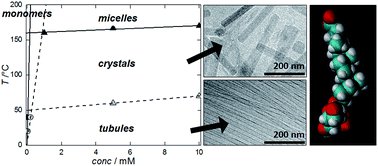
RSC Adv., 2017,7, 512-517
https://doi.org/10.1039/C6RA26092F
About this collection
Welcome to this themed collection on ‘Supramolecular Chemistry’, guest edited by Professor Xiao-Yu Hu (Nanjing University of Aeronautics and Astronautics) and Associate Editor Professor Leyong Wang (Nanjing University). This themed collection focuses on supramolecular self-assembly and its applications. It includes 40 recently published original research papers and 2 reviews covering many research areas related to supramolecular assemblies and their potential applications or functional behaviors, ranging from host-guest systems, supramolecular polymers and gels, to functional supramolecular materials. The purpose of this collection is to provide an overview of the versatile research field of supramolecular chemistry, as well as a platform for researchers to promote its rapid development and realise the bright future of supramolecular systems.